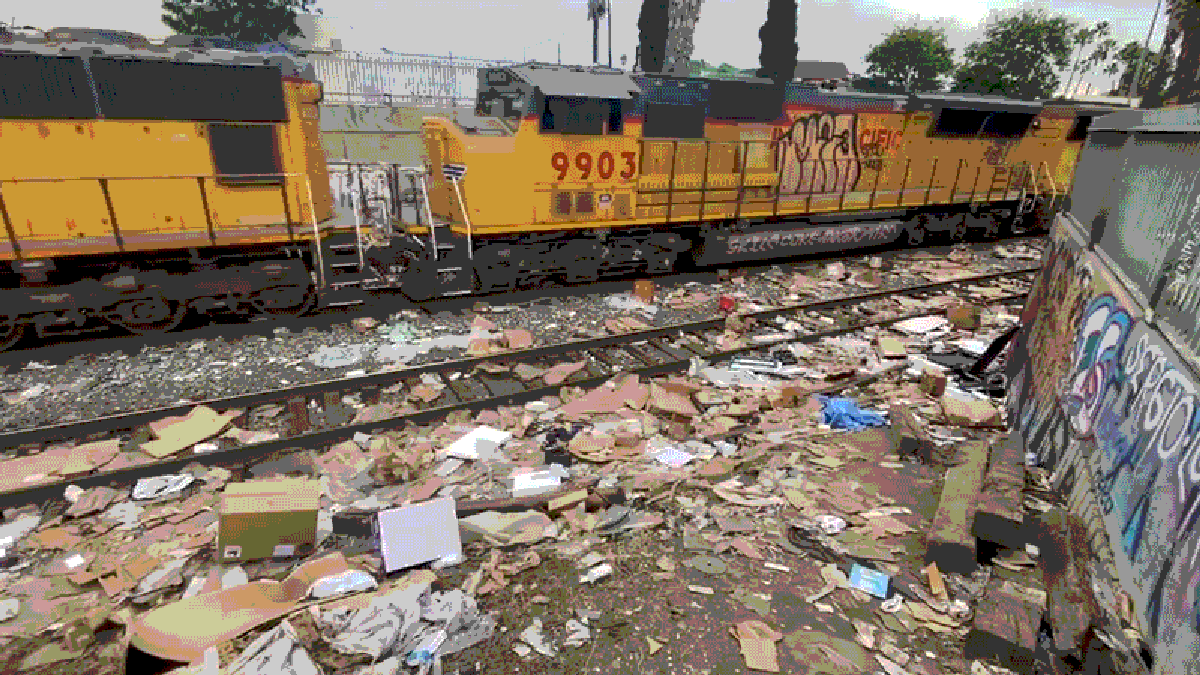Train heists seem like the kind of crime left behind with wagon trails and high-noon duels, but the problem is a major headache in our modern world. A new fascinating deep dive by the New York Times shows just how this land piracy works, and what everyone from train companies to large corporations to the feds are doing about it.
The Times starts its investigation in Los Angeles, the undisputed capital of train robberies. You might remember back in 2022 when Union Pacific trains went viral for traveling down tracks strewn with empty packages and discarded items. Well, things have not improved in the two years since we covered that story.
Edward Hall, President of the Brotherhood of Locomotive Engineers and Trainmen, broke down for the Times just how such thefts occur:
Up in the cab, Hall told me, he regularly passed stopped trains and saw people clambering up ladders or loading cargo into their trucks pulled up alongside the tracks. Sometimes he saw people breaking into moving trains too. He would call the rail police dispatcher and keep going. Those container doors, meanwhile, stayed open, he said, trailing boxes as the train rolled on. Hall saw all kinds of merchandise spread out across the tracks, including tires and televisions. Engineers don’t stop for this flotsam of global capitalism; they run over it. Once, near the Dragoon Mountains, in southeast Arizona, Hall drove a train through a desolate quarter-mile of track littered with hundreds of pairs of Nike sneakers. “Between L.A. and Tucson is where I know a lot of theft happens,” Hall said.
The most extreme type of modern train theft occurs when thieves cut the air-compression brake hoses that run between train cars, thereby triggering an emergency braking system. When that happens, the engineer stays in the cab and the conductor walks the length of the stopped train, trying to locate the source of the problem. (Thieves can also stop a train by decoupling some of its cars.) Of course, if a train is miles long, that walk takes a while. In the meantime, the pilferers unload.
Law-enforcement officials told me that it’s not uncommon for thieves to target specific cars full of electronics, say, or tires, in a way that suggests previous knowledge of their contents. Gary Rogers, a former Union Pacific law-enforcement agent, says that during his decades working throughout the West, he saw thieves coordinate their movements precisely; one of them would climb aboard a moving train and know just when and to what extent to cut into the air-compression hose. “The train would stop, and the guys would be there waiting to unload,” Rogers told me. It’s easy to imagine how frightening a heist might be for a train engineer and conductor, but in cases when the train has not been stopped, they often have no idea it’s even happening. Sometimes they won’t know for hundreds, maybe thousands, of miles, until they arrive at their destination and discover looted cars.
After the thieves take off, the items are sometimes stored in vast subleased warehouses before being resold. E-commerce has not only increased the piracy problem by providing more and better targets for thieves, but it also serves as a laundering system, obscuring the origin of stolen items. Items stolen from say, an Amazon shipment, might end up back on Amazon through some shady third-party seller.
The entire report is fascinating, diving into the effects of income quality, global shipping and the history of the American train heist. You can check it out here.
Source link
#Modern #Day #Train #Heist



